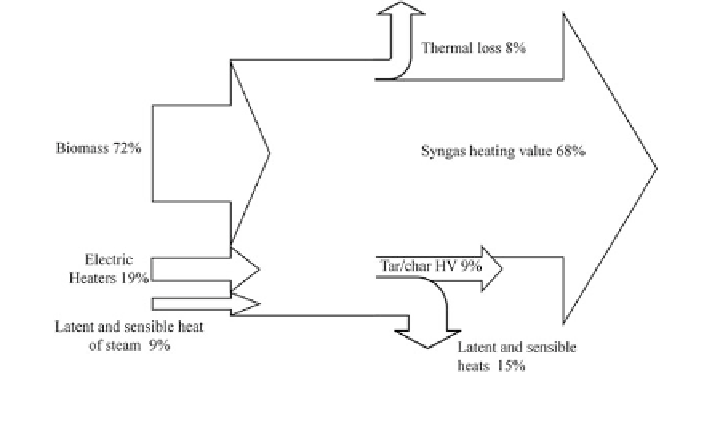Environmental Engineering Reference
In-Depth Information
Fig. 13 Energy
fl
flow diagram for maximum energy efficiency case. (T = 857
°
C, S/B = 0.75,
= 2.4 s)
τ
of the syngas. As shown in the previous section, the heating value of the syngas
decreased as the reactor temperatures rose, but the total heating content (heating
value x
flow rate) increased. An increase in temperature would most likely increase
the conversion ef
fl
ciency further. Adding a heat exchanger could also increase the
energy ef
ciency. Recovery of any of the sensible heats of the steam or syngas
mixture would reduce the required energy input and increase energy ef
ciency.
ciency case is shown in
Fig.
13
. The biomass heating value accounted for 72 % of the energy input, while
19 % was required to heat the reactor bed and 9 % for the generation of steam. The
total process energy converted to chemical potential in the syngas was 68 %.
Reactor thermal losses consumed 8 % of the input energy. This portion can be
reduced by better insulating the reactor. The thermal loss during this test was
7.8 kW. Lower thermal losses were accomplished after this particular test with
better insulation wrapping. The results presented here are using the measured losses
to accurately portray testing.
The Latent and sensible heat contained by the steam and syngas accounted for
15 % of the total energy. This energy is available to be recycled back into the system
using heat exchangers. Because of the higher tar content produced at low S/B ratios,
some form of tar treatment will be needed to prevent reduction in heat exchanger
ef
A heat
fl
flow diagram for the maximum energy ef
ciency. The easiest way to prevent tar buildup in a heat exchanger is only cool
the syngas mixture down to 400
C. In this way, most of the tars are prevented
from condensing. While effective, this method will limit the amount of recoverable
heat. Another option is to use a catalytic tar reformer. This heated vessel will remove
most of the tars and thus allow the gas to pass through a heat exchanger that can
utilize the full energy potential of the heated gas. Although this adds infrastructure
and energy cost to maintain another bed at high gasi
°
cation temperatures.

Search WWH ::

Custom Search